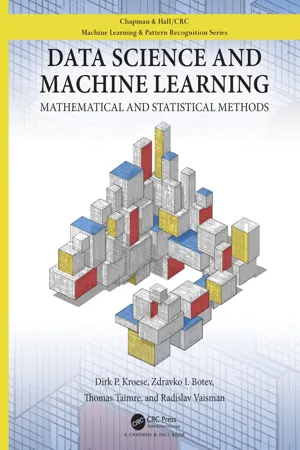
Data Science and Machine Learning
Mathematical and Statistical Methods
- 510 pages
- English
- ePUB (mobile friendly)
- Available on iOS & Android
Data Science and Machine Learning
Mathematical and Statistical Methods
About this book
"This textbook is a well-rounded, rigorous, and informative work presenting the mathematics behind modern machine learning techniques. It hits all the right notes: the choice of topics is up-to-date and perfect for a course on data science for mathematics students at the advanced undergraduate or early graduate level. This book fills a sorely-needed gap in the existing literature by not sacrificing depth for breadth, presenting proofs of major theorems and subsequent derivations, as well as providing a copious amount of Python code. I only wish a book like this had been around when I first began my journey!" -Nicholas Hoell, University of Toronto
"This is a well-written book that provides a deeper dive into data-scientific methods than many introductory texts. The writing is clear, and the text logically builds up regularization, classification, and decision trees. Compared to its probable competitors, it carves out a unique niche. -Adam Loy, Carleton College
The purpose of Data Science and Machine Learning: Mathematical and Statistical Methods is to provide an accessible, yet comprehensive textbook intended for students interested in gaining a better understanding of the mathematics and statistics that underpin the rich variety of ideas and machine learning algorithms in data science.
Key Features:
- Focuses on mathematical understanding.
- Presentation is self-contained, accessible, and comprehensive.
- Extensive list of exercises and worked-out examples.
- Many concrete algorithms with Python code.
- Full color throughout.
Further Resources can be found on the authors website: https://github.com/DSML-book/Lectures
Frequently asked questions
- Essential is ideal for learners and professionals who enjoy exploring a wide range of subjects. Access the Essential Library with 800,000+ trusted titles and best-sellers across business, personal growth, and the humanities. Includes unlimited reading time and Standard Read Aloud voice.
- Complete: Perfect for advanced learners and researchers needing full, unrestricted access. Unlock 1.4M+ books across hundreds of subjects, including academic and specialized titles. The Complete Plan also includes advanced features like Premium Read Aloud and Research Assistant.
Please note we cannot support devices running on iOS 13 and Android 7 or earlier. Learn more about using the app.
Information
CHAPTER 1
IMPORTING, SUMMARIZING, AND VISUALIZING DATA
1.1 Introduction
abalone data set from this website with Python, download the file to your working directory, import the pandas package viairis data set from R’s datasets package into Python, type:Table of contents
- Cover
- Half Title
- Title Page
- Copyright Page
- Dedication
- Table of Contents
- Preface
- Notation
- 1 Importing, Summarizing, and Visualizing Data
- 2 Statistical Learning
- 3 Monte Carlo Methods
- 4 Unsupervised Learning
- 5 Regression
- 6 Regularization and Kernel Methods
- 7 Classification
- 8 Decision Trees and Ensemble Methods
- 9 Deep Learning
- A Linear Algebra and Functional Analysis
- B Multivariate Differentiation and Optimization
- C Probability and Statistics
- D Python Primer
- Bibliography
- Index